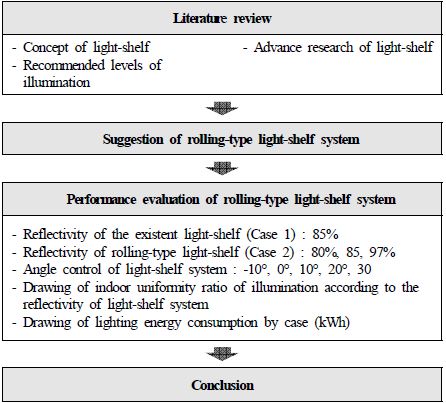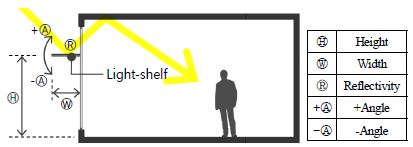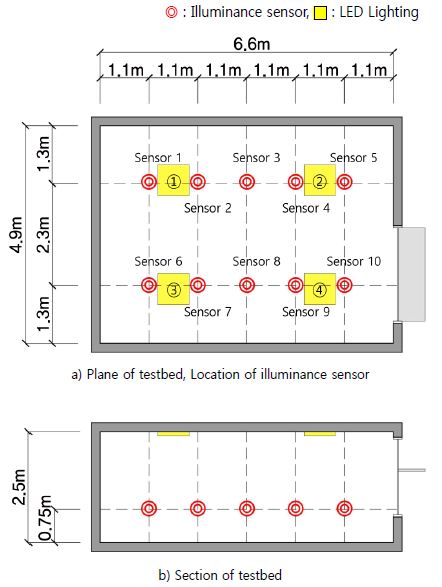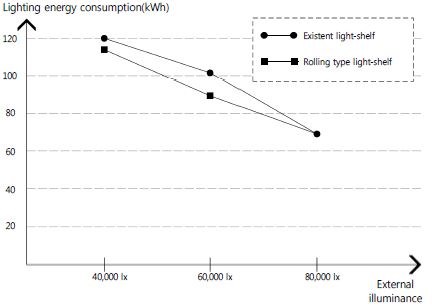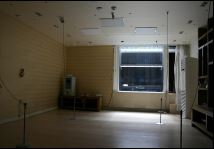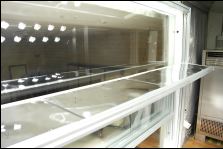
반사율 변경이 가능한 롤링타입형 광선반 개발
©Copyright Korea Institute of Ecological Architecture and Environment
Abstract
Recently, lighting energy consumption in buildings has been gradually increasing and more studies are being carried out in order to solve this problem. Especially, the efficiency of the light-shelf system, which is a natural lighting system, has been recognized as a potential solution in addressing this problem and so various studies regarding the light-shelf system are being conducted. However, if high luminance material is used for the light-shelf system, glaring may occur in certain circumstances even though such material increases efficiency, and there are also difficulties related to maintenance and management in the case of an external light-shelf system. Therefore, the purpose of this study is to suggest modifications in relation to the reflectivity of the light-shelf system and introduce a rolling type light-shelf system with built-in cleaning equipment. In addition, a performance evaluation technique was established to verify its effectiveness.
In this study, we reviewed previous studies related to the light-shelf system and its performance. Then a testbed was established to assess the performance of the rolling-type light-shelf system suggested in this study. Also, the performance of the rolling-type light-shelf system suggested in this study was compared and analyzed with that of existent light-shelf systems in order to better verify the performance, and the uniformity ratio of illumination and lighting energy consumption were calculated for this purpose.
The results of the performance evaluation are as follows. 1) The performance evaluation result of the light-shelf system on the day of the summer solstice shows that 30° is appropriate for the angle of light-shelf system, and the depth of the incoming natural light also increases as the angle of the light shelf increases. 2) It is possible to improve the uniformity ratio of illumination by increasing the reflectivity of the light shelf, and the reason for this is the increase in the amount of incoming light entering indoors due to the increased reflectivity of the light shelf. 3) The rolling type light-shelf system suggested in this study enables energy saving in comparison with existent light-shelf systems, and when the external illuminance decreases to 60,000 lx and 40,000 lx during the summer solstice due to factors such as the weather, the suggested light-shelf system can save energy by 12.1% and 5.1% respectively. Thus the light-shelf system proposed in this study is deemed to be effective in reducing energy costs.
Keywords:
Light-Shelf, Reflectivity, Rolling type, Evaluation performance, Energy saving키워드:
광선반, 반사율, 롤링타입, 성능평가, 에너지저감1. 서론
1.1. 연구의 배경 및 목적
2012년 IEA(International Energy Agency)의 상업용 에너지 사용량에 관한 자료에 의하면, 조명에너지 사용량은 21%를 차지하고 있으며,1) 점차 증가할 것이라 보고되고 있다. 또한, 에너지관리공단의 2013년 국내의 에너지 사용에 대한 자료에 의하면 조명에너지 사용량은 건물부문의 전체에너지 사용량에 대비하여 19.4%로 높게 나타나고 있어서 이를 해결하고자 하는 연구와 기술개발은 지속적으로 요구되고 있다.2) 이에 광선반은 자연채광시스템의 하나로써 외부 자연광을 반사를 통하여 실내로 깊숙이 유입시켜 실내 빛환경 개선 및 조명에너지 저감이 가능하다는 측면에서 효율을 인정받아 다양한 연구가 진행되고 있다. 최근 광선반에 관한 연구는 외부환경에 대응하기 위하여 다양한 제어기술이 접목되고 있으며,3) 특히 광선반은 각도 제어가 가능한 가동형 광선반이 개발되어 있다. 그러나 기존 광선반은 높은 고휘도 반사율을 적용시 채광선능을 개선할 수 있음에도 특정상황에 현휘가 발생할 수 있다는 측면을 고려하여 85%의 수준의 반사율로 제한하여 연구4)가 진행되고 있다. 또한, 광선반 형태 중 하나인 외부형 광선반은 채광성능이 우수하여 적용사례가 증가하고 있으나 외부에 설치된다는 점에서 광선반 관리 상태에 따라 성능이 결정되며,5) 특히 도심에 노출된 외부형 광선반은 시간이 경과함에 따라서 광선반 반사판이 오염되어서 성능이 저하될 우려가 있다.
이에 본 연구는 광선반에 롤링 기술을 적용하여 반사율 조정 및 반사판 표면의 청소를 통한 광선반의 성능유지가 가능한 롤링타입형 광선반을 개발한다. 이후 실스케일의 테스트베드를 통한 성능평가 및 유효성 검증을 목적으로 한다.
1.2. 연구의 절차 및 범위
본 연구는 롤링타입형 광선반을 개발 및 성능평가를 진행하며, <그림1>에서 나타나듯이 다음과 같은 절차에 의거하여 진행하였다. 첫 번째, 광선반 개념, 변인과 광선반 관련 선행연구 고찰을 실시하였으며, 또한 광선반 성능평가를 위한 국내 실내 조도 기준을 고찰하였다. 두 번째, 고찰된 내용을 기반으로 롤링타입의 광선반을 제안하였다, 세 번째, 기존의 광선반과 본 연구에서 제안하는 롤링타입형 광선반의 성능을 비교 및 분석하기 위하여 테스트베드를 구축하였으며, 각 Case에 따른 조명 전력 사용량을 산출하여 성능평가를 진행하였다.
단, 본 연구는 건물 에너지 사용량이 높게 나타나는 하지로 국한하였으며, 특히 하지의 경우에 광선반 효율이 높게 나타난다는 선행연구6)를 근거하였다.
2. 광선반 및 실내 조도기준 고찰
2.1. 광선반의 개념 및 변인
광선반은 <그림2>에서 나타나듯이 외부 자연광을 광선반의 반사를 통하여 실내로 입시키는 자연채광시스템으로 효율적인 조명에너지 저감이 가능하며, 외부 자연광이 직접적으로 실내로 유입되는 것을 차단함으로써 실내의 빛환경 개선이 가능하다. 광선반의 성능을 결정짓는 변인은 광선반의 타입, 높이, 각도, 폭, 반사율이 있다.
2.2. 광선반의 선행연구 고찰
광선반과 관련한 선행연구는 <표1>에서 나타나듯이 특정 반사율로 고정하고 있으며, 이는 기상 등에 의하여 달라지는 외부조도에 적극적으로 대응하기 힘들다. 특히 운량이 많은 경우 외부조도가 낮아지며, 이 경우 고휘도 재료를 광선반의 반사판으로 사용할 경우 효율적이나 현휘 등의 문제가 발생할 수 있다. 또한, 광선반은 반사를 통하여 실내로 빛을 유입한다는 측면에서 광선반의 반사판의 관리는 중요한 요소이나 이에 대한 해결안을 제시하는 연구는 부재한 상태이다.
3. 롤링타입형 광선반 제안 및 성능평가
3.1. 롤링타입형 광선반 제안
본 연구에서 제안하는 롤링타입의 광선반은 <그림3>에서 나타나듯이 롤링을 통하여 광선반의 반사율을 80%, 85%, 97%로 설정하였다. 광선반의 반사율 설정은 반사율 80% 미만의 광선반을 설치시 조명에너지 사용량이 증가한다는 기존 연구18)를 근거로 80%의 반사율을 최소 반사율로 설정하였으며, 85%는 기존의 연구에서 적용하고 있는 반사율이다. 또한 반사율 97%의 고휘도는 제조업체의 제품스펙19)을 근거하여 설정하였다.
본 연구에서 제안하는 롤링타입형 광선반은 자동제어가 되도록 제안하며, 재실자가 입실시 롤링타입형 광선반은 최초 반사율 80%인 상태에서 각도제어를 우선적으로 진행하며, 각도제어는 실내 공간의 조도가 400 lx를 만족하면 종료한다. 단, 광선반의 각도제어 이후에도 400 lx를 만족하지 않을시 롤링타입형 광선반은 롤링을 통하여 광선반의 반사율을 85%, 97% 순으로 증가시켜 400 lx를 만족하도록 제어한다. 본 롤링타입형 광선반의 각도 제어 및 반사율 조정에도 400 lx를 만족하지 않을 경우에는 조명제어를 실시하며, 조명제어에 따른 전력 사용량은 이후 성능평가를 위한 지표로 활용하였다. 또한, 롤링타입형 광선반은 극세사 소재의 청소기구가 내장되어 있어서 롤링 과정중 반사판의 오염물질을 제거하여 효율 높은 광선반을 유지할 수 있도록 제안하였다.
3.2. 성능평가 환경설정
본 연구는 롤링타입형 광선반의 성능평가를 진행하기 위하여 테스트베드를 구축하였으며, 테스트베드는 <표3>에서 나타나듯이 폭 4.9m, 깊이 6.6m, 높이 2.5m의 크기이다. 또한, 광선반이 부착되는 채광창의 크기는 폭 2.2m, 높이 1.8m의 크기이며, 창의 크기는 국토해양부의 창호 설계 가이드라인에서 제시하는 창면적비 40%이하시 에너지 저감에 효율적이라는 내용을 근거로 조정한 결과이다. 또한, 성능평가를 위하여 테스트베드의 챔범에는 인공태양광 조사장치를 구축하였으며, 인공태양광 조사장치는 광원의 광량, 높이 및 각도 설정이 가능하여 성능평가를 위한 외부 빛환경 조성이 가능하다. 본 연구는 광선반 성능평가의 정량적인 분석 자료로 조명에너지 사용량을 산축하기 위하여 조명을 설치하였으며, 조명의 위치는 IES의 4점법에 의거하여 8단계 디밍 조명제어가 가능한 4개의 LED 타입 조명을 설치하였다.
성능평가를 위한 실내 조도 센서는 <그림4>에서 나타나듯이 총 10개이며, 공간의 크기를 고려하여 1.1m의 등간격으로 2열로 배치하였다. 조도센서의 위치는 실내평균조도 도출을 위한 조도센서 위치가 채광창으로부터 4.4m의 지점에서 측정하는 것이 적합하다는 연구20)결과를 근거하며, 조도센서의 높이는 작업면 높이를 고려하여 바닥으로부터 750mm에 위치시켰다.
3.3. 성능평가 방법
본 연구는 롤링타입형 광선반 성능평가를 위하여 기존의 광선반과 성능을 비교 및 분석하였으며, 성능평가를 위한 광선반 Case 별 변인은 <표4>와 같다. 광선반의 높이는 재실자의 눈높이 및 선행 연구16)의 채광성능 결과를 고려하여 1.8m로 고정하였으며, 각도는 –10°에서 30°까지 10°단위로 구분하였다. 또한, 광선반의 폭은 기존 연구를 근거하여 0.3m로 설정하였으며, 단 롤링타입형 광선반은 롤링시스템 적용하기 위하여 0.43m로 광선반 폭이 증가하였으나 실제적으로 반사가 이루어지는 광선반의 폭은 Case 1의 기존 광선반과 동일한 0.3m이다. 앞서서 언급하였듯이 기존 광선반은 85% 고정하였으며, 롤링타입형 광선반은 80%, 85%, 97%로 조정 가능하도록 하였다.
본 연구에서 제안하는 롤링타입형 광선반 성능평가 방법은 다음과 같다.
첫 번째, 본 연구는 광선반 성능평가를 진행하기 위하여 앞서서 성능평가 환경 및 Case를 설정하였으며, 이에 따른 실내 조도 분포를 분석하였다. 실내 조도 분석을 통하여 균제도를 산출하여 광선반 반사율에 따른 빛환경 개선 여부를 판단하였다.
두 번째, 앞서서 언급하였듯이 광선반의 각도 및 롤링제어 이후에도 400 lx를 만족하지 못한 경우에는 조명제어를 실시하며, 조명제어는 조명센서 2, 4, 7, 9번과 조명 1, 2, 3, 4와 각각 연동시켜 가장 낮은 조도 값을 보이는 센서와 연동된 조명부터 디밍제어를 순차적으로 진행하였다. 조명제어 간 조도센서 2, 4, 7, 9번이 모두 400 lx를 만족시 조명제어를 종료하도록 하였으며, 각 Case별 조명 전력사용량은 조명제어 이루어진 후 1시간에 대하여 도출하여 성능평가에 반영하였다. 성능평가를 위한 외부조도는 설정은 관련 연구5)를 근거하여 8만 lx를 기준으로 6만 lx, 4만 lx인 상황을 추가하여 성능평가를 진행하였다. 단, 외부 조도의 설정은 정남형의 상황에 대하여 기상 등의 요인에 의해 낮아지는 경우를 고려한 설정이다.
3.4. 성능평가 결과
본 연구에서 제안하는 롤링타입형 광선반은 기상 등의 요인에 의하여 외부조도가 낮아져 효율이 낮아지는 광선반의 문제를 해결하기 위하여 광선반의 반사율 변경이 가능하도록 제안하였으며, 이에 대한 성능평가 결과는 다음과 같다.
첫 번째, 본 연구에서 설정한 광선반 변인에 따른 성능평가 결과 하지시의 광선반 적정 각도는 30°로 나타나고 있으며, 하지시의 광선반 각도의 증가는 반사를 통하여 실내로 유입되는 자연광의 깊이를 증가시켜 채광성능에 유리하게 나타나는 결과이다.
두 번째, 광선반의 반사율 증가는 <표5>에서 나타나듯이 실내 균제도 개선이 가능하며, 이는 광선반 반사율 증가함에 따라서 실내로 유입되는 광량의 증가가 원인으로 분석된다.
세 번째, 본 연구에서 제안하는 롤링타입형 광선반은 <그림5>에서 나타나듯이 기존 광선반에 대비하여 에너지 저감이 가능하며, 특히 성능평가에서 설정한 외부조도 6만 lx, 4만 lx 등과 같이 기상 등의 요인으로 외부조도가 낮아지는 경우 각각 12.1%, 5.1%의 에너지 저감이 가능하여 유효하게 분석된다.
4. 결론
본 연구는 기존 외부형 광선반이 가지는 관리 상의 문제 및 기상 등의 원인으로 외부조도가 낮아져 채광성능이 저하되는 문제를 해결하기 위하여 롤링타입형 광선반을 제안하였으며, 실스케일의 테스트베드를 구축하여 성능평가를 진행하였다. 이에 대한 결론은 다음과 같다.
첫 번째, 본 연구에서 제안하는 롤링타입형 광선반은 광선반의 반사율을 80%, 85%, 97%의 3가지 타입으로 변경이 가능하도록 하였으며, 극세사 소재의 청소기구가 내장되어 채광성능 유지 및 관리가 이루어지도록 하였다.
두 번째, 하지시의 광선반 성능평가 결과 광선반 각도 30°가 적정하며, 이는 광선반 각도의 증가에 따라 유입되는 자연광의 깊이가 증가한 결과이다.
세 번째, 광선반의 반사율 증가를 통하여 균제도 개선이 가능하며, 이는 광선반 반사율 증가에 따른 실내 유입되는 광량의 증가를 그 원인으로 찾을 수있다.
네 번째, 본 연구에서 제안하는 롤링타입형 광선반은 기존 광선반에 대비하여 에너지 저감이 가능하며, 하지의 경우 기상 등의 원인으로 인한 외부조도가 6만 lx, 4만 lx로 낮아지는 경우 각각 12.1%,5.1%의 에너지 저감이 가능하여 유효하게 분석된다.
본 연구는 광선반의 채광성능 개선 뿐만 아니라 기존에 문제시된 외부형 광선반의 관리적 측면에 대한 해결책을 제안한다는 측면에서 유의미하나, 하지 등의 특정상황으로 국한하였다는 점은 본 연구의 한계이다. 이에 차후에는 다양한 상황 및 개발에 대한 타당성 검토를 고려한 연구가 후속되어야 할 것이다.
Acknowledgments
This work was supported by the National Research Foundation of Korea Grant funded by the Korean Government(NRF-2015R1C1A1A01052784)
Notes
김상훈, 이행우, 서장후, 김용성, “에너지 저감을 위한 주거공간 내 위치인식기술 적용 광선반 시스템 개발연구”, 설비공학논문집, 제26권 제 6호, 2014 // (Kim Sanghun, Lee Heangwoo, Seo Janghoo, Kim Yongseong, A Study on Light-Shelf System using Location-Awareness Technology for Energy Saving in Residential Space. Korean Journal of Air-Conditioning and Refrigeration Engineering, Vol.26, No.6, 2014.06)
권순현, 이행우, 서장후, 김용성, “주거공간 내 사용자인식기술 및 조명 디밍제어 적용광선반 시스템 성능평가 연구”, 대한건축학회논문집 계획계, 제30권 제2호, 2014 // (Kwon Sunhyeon, Lee Heangwoo, Seo Janghoo, Kim Yongseong, A Study on Light Shelf System Performance Evaluation Applying User Awareness and Dimming Control in Housing. Journal of the architectural institute of Korea planning & design, Vol.30, No.2, 2014.02)
안혜영, 이행우, 김용성, “주거공간을 위한 IT결합 광선반시스템 개발 연구”, 한국생태환경건축학회 논문집, 제13권 제1호, 2013 // (Ahn Hye-young, Lee Heangwoo, Kim Yongseong, A Study on Light-shelf system based on IT in Housing Space. KIEAE Journal, Vol.13, No.1, 2013.02)
이행우, Kyle Eric Rogers, 서장후, 김용성, “결정면 적용 광선반 채광성능 평가 연구”, 설비공학논문집, 제27권 제8호, 2015 // (Lee Heangwoo, Kyle Eric Rogers, Seo Janghoo, Kim Yongseong, A Study on Lighting Performance Evaluation of Light-Shelf using Crystal Face . Korean Journal of Air-Conditioning and Refrigeration Engineering, Vol.27, No.8, 2015.08)
채우리, 이행우, 서장후, 김용성, “주거공간의 혼합형 광선반 각도 변화에 따른 채광성능 평가”, 설비공학논문집, 제26권 제9호, 2014 // (Chae Woori, Lee Heangwoo, Seo Janghoo, Kim Yongseong, Evaluation of Lighting Performance of Mixed Type Light-shelf in Residential Space According to Angular Variations. Korean Journal of Air-Conditioning and Refrigeration Engineering, Vol.26, No.9, 2014.09)
박병일, 양인호, 나미현, “사무소 건물에서 광선반의 채광성능 분석”, 조명전기설비학회논문지, 제22권 제8호, 2008 // (Park Byung-il, Yang In-ho, Na Mi-hyun, An Analysis of Daylighting Performance of Light Shelf in Office Building. Journal of the Korean Institute of illuminating and Electrical Installation Engineers, Vol.22, No89, 2008.08)
서태원, 이행우, 김용성, “주거공간 내 사용자인식기술 적용 조명에너지 저감 광선반시스템 연구”, 대한건축학회논문집 계획계, 제28권 제11호, 2012.11 // (Seo Taewon, Lee Heangwoo, Kim Yongseong, A Study on Light-Shelf System using Context Awareness Technology for Energy Saving in Housing Space. Journal of the architectural institute of Korea planning & design, Vol.28, No.11, 2012.11)
References
- International Energy Agency, World Energy Outlook 2012, (2012).
-
한국에너지공단, 2013년 에너지사용량 통계 발표, (2014).
Korea Energy Agency, Energy consumption statistics 2013, (2014). -
서태원, 이행우, 김용성, “주거공간 내 사용자인식기술 적용 조명에너지 저감 광선반 시스템 연구”, 대한건축학회논문집 계획계, 28(11), (2012, Nov).
Seo , Taewon, Lee , Heangwoo, Kim , Yongseong, A Study on Light-Shelf System using Context Awareness Technology for Energy Saving in Housing Space, Journal of the architectural institute of Korea planning & design, 28(11), (2012, Nov). -
김상훈, 이행우, 서장후, 김용성, “에너지 저감을 위한 주거공간 내 위치인식기술 적용 광선반 시스템 개발연구”, 설비공학논문집, 26(6), (2014).
Kim , Sanghun, Lee , Heangwoo, Seo , Janghoo, Kim , Yongseong, A Study on Light-Shelf System using Location-Awareness Technology for Energy Saving in Residential Space, Korean Journal of Air-Conditioning and Refrigeration Engineering, 26(6), (2014, Jun). -
권순현, 이행우, 서장후, 김용성, “주거공간 내 사용자인식기술 및 조명 디밍제어 적용 광선반 시스템 성능평가 연구”, 대한건축학회논문집 계획계, 30(2), (2014).
Kwon , Sunhyeon, Lee , Heangwoo, Seo , Janghoo, Kim , Yongseong, A Study on Light Shelf System Performance Evaluation Applying User Awareness and Dimming Control in Housing, Journal of the architectural institute of Korea planning & design, 30(2), (2014, Feb). [https://doi.org/10.5659/JAIK_PD.2014.30.2.285]
-
안혜영, 이행우, 김용성, “주거공간을 위한 IT결합 광선반시스템 개발연구”, 한국생태환경건축학회 논문집, 13(1), (2013).
Ahn , Hye-young, Lee , Heangwoo, Kim , Yongseong, A Study on Light-shelf system based on IT in Housing Space, KIEAE Journal, 13(1), (2013, Feb). -
오상원, 이행우, 서장후, 김용성, “주거공간 내 광선반 곡률 형태에 따른 채광성능평가 연구”, 설비공학논문집, 27(6), (2015).
Oh , Sangwon, Lee , Heangwoo, Seo , Janghoo, Kim , Yongseong, Research on Lighting Performance Evaluation for Different Curvature Reflection Rate in Residential Space, Korean Journal of Air-Conditioning and Refrigeration Engineering, 27(6), (2015, Jun). [https://doi.org/10.6110/KJACR.2015.27.6.328]
-
이행우, Kyle , Eric Rogers, 서장후, 김용성, “결정면 적용 광선반 채광성능 평가 연구”, 설비공학논문집, 27(8), (2015).
Lee , Heangwoo, Kyle , Eric Rogers, Seo , Janghoo, Kim , Yongseong, A Study on Lighting Performance Evaluation of Light-Shelf using Crystal Face , Korean Journal of Air-Conditioning and Refrigeration Engineering, 27(8), (2015, Aug). [https://doi.org/10.6110/KJACR.2015.27.8.395]
-
채우리, 이행우, 서장후, 김용성, “주거공간의 혼합형 광선반 각도 변화에 따른 채광성능 평가”, 설비공학논문집, 26(9), (2014).
Chae , Woori, Lee , Heangwoo, Seo , Janghoo, Kim , Yongseong, Evaluation of Lighting Performance of Mixed Type Light-shelf in Residential Space According to Angular Variations, Korean Journal of Air-Conditioning and Refrigeration Engineering, 26(9), (2014, Sep). [https://doi.org/10.6110/KJACR.2014.26.9.424]
-
박병일, 양인호, 나미현, “사무소 건물에서 광선반의 채광성능 분석”, 조명전기설비학회논문지, 22(8), (2008).
Park , Byung-il, Yang , In-ho, Na , Mi-hyun, An Analysis of Daylighting Performance of Light Shelf in Office Building, Journal of the Korean Institute of illuminating and Electrical Installation Engineers, 22(89), (2008, Aug). -
박병일, 양인호, 나미현, “사무소 건물에서 광선반의 채광성능 분석”, 조명·전기설비학회논문지, 22(8), (2008).
Park , Byungil, Yang , Inho, Na , Mihyun, An Analysis of Daylighting Performance of Light Shelf in Office Building, Journal of the Korean institute of illuminating and electrical installation Engineers, 22(8), (2008, Aug). -
이행우, 김덕수, 서장후, 김용성, “천장의 기하학적 형태에 따른 광선반 성능평가 시뮬레이션 연구”, 설비공학논문집, 26(4), (2014).
Lee , Heangwoo, Kim , Duk-su , Seo , Janghoo, Kim , Yongseong, Simulation Study on the Performance Evaluation of Light-shelf According to Geometric Shape of Ceiling, Korean Journal of Air-Conditioning and Refrigeration Engineering, 26(4), (2014, Apr). [https://doi.org/10.6110/KJACR.2014.26.4.181]
-
최유창, “타공반사판 적용 외부형 광선반의 조명에너지 성능평가에 관한 연구”, 국민대학교 테크노디자인전문대학원 석사학위논문, (2016).
Choi , Yuchang, Evaluation of the Application of am External Perforated Reflector on a Light-Shelf, A master’s thesis of Graduate School of Techno Design Kookmin University, (2016, Feb). -
김정태, 신현구, 김곤, “광반사를 이용한 광선반 채광시스템의 기본형상 설계 및 성능평가에 관한 연구”, 대한건축학회논문집 계획계, 19(3), (2003).
Kim , Jeongtai, Shin , Hyungu, Kim , Gon, Design and Performance of Horizontal Light-Redirecting Devices in Offices, 19(03), (2003, Mar). -
한설이, 최선우, 박효순, 서승직, “사무소 건물에서 광선반의 종류에 따른 실내조도와 조명에너지 분석”, 한국생태환경건축학회 학술발표대회 논문집, (2012, May).
Han , Seolyea, Choi , Seonwoo, Park , Hyosoon, Suh , Seungjik, Analysis of the Indoor Illuminance and the Lighting Energy according to the Light Shelves in the Office Building, Korea Institute of Ecological Architecture and Environment, (2012, May). -
정유근, “창호거치 태양광발전 가변형광선반 설계 및 기초적 발전성능에 관한 연구”, 한국생태환경건축학회 논문집, 13(6), (2013).
Jung , Yoogeun, A Study on the Design and Power Performance of a Variable Photovoltaic Lightshelf Mounted on the Windows, Journal, 13(6), (2013, Dec). -
문기훈, 김정태, “Lightscape를 이용한 광선반 창호시스템의 채광성능평가”, 한국생태환경건축학회 논문집, 4(4), (2004).
Moon , Kihoon, Kim , Jungtea, Daylighting Performance Evaluation of Lightshelf Window System by Lightscape, KIEAE Journal, 4(4), (2004, Dec). -
이현우, 이시내, “사무소 건물에서 수평형 광선반을 이용한 빛환경개선”, 한국생활환경학회지, 18(1), (2011).
Lee , Hyunwoo, Lee , Sinae, The Improvement of Uniformity Ratio for Luminous Environment Using Horizontal Lightshelf in an Office Building, Journal of The Korean Society of Living Environmental Systeml, 18(1), (2011, Feb). -
이행우, 김덕수, 김용성, “실내공간 깊이와 광선반 규격 변화에 의한 광선반 성능평가 시뮬레이션 연구”, 대한건축학회논문집 계획계, 29(3), (2013).
Lee , Heangwoo, Kim , Duksoo, Kim , Yongseong, Simulation Study on the Performance Evaluation of Light-shelf focused on the Depth of Space and the Dimensions and Angles of Light-shelf, Journal of the architectural institute of Korea planning & design, 29(3), (2013, Mar). -
허도연, 이행우, 서장후, 김용성, “반사율에 따른 광선반 채광 성능평가 연구”, 한국생태환경건축학회 논문집, 15(3), (2015).
Heo , Doyeon, Lee Heangwoo, Seo Janghoo, Kim Yongseong, Lee , Heangwoo, Seo , Janghoo, Kim , Yongseong, Daylighting Performance Evaluation of Light-shelf according to the Reflectivity, KIEAE Journal, 15(3), (2015, Jun). - 3M, Construction Markets, Product Information.
-
정봉근, 최안섭, “광센서 조광제어시스템의 광센서 최적 방향성과 위치에 관한 실험적 연구”, 조명·전기설비학회논문지, 17(5), (2003).
Jung , Bongkeun, Choi , Anseop, An Experimental Study of the Optimum Spatial Characteristics and Location of Photosensor for Daylight Responsive Dimming Systems, Journal of the Korean institute of illuminating and electrical installation Engineers, 17(5), (2003, Sep).
